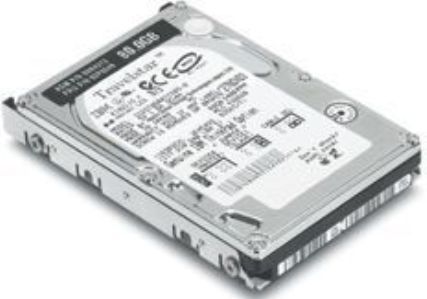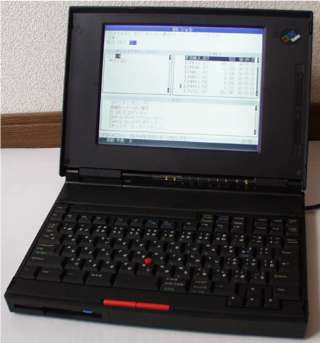For those of you who didn't read the blog below, this is a Lenovo Ideapad S10-2 netbook. I ordered mine with a N280 processor instead of the standard N270 processor, which gives a 0.06GHz increase in speed to 1.66GHz. The FSB (Front Side Bus) speed is also increased from 533MHz to 667MHz. If this will give any noticeable difference in daily life is doubtful, but I chose to do this to get the most up to date specs. The other specifications are pretty similar to most other netbooks; a 160GB hard drive (Western Digital) and 1GB of RAM in one single SODIMM slot. According to crucial.com, the maximum possible RAM is upgrade is to 2GB, probably limited by the chipset. On the outside we find the standard 3 USB ports, a VGA port, a RJ45 network port, SD card reader and headphone/microphone jacks. The 3rd USB port is really nice, as you can end up using 2 of them for mouse and keyboard if you use the netbook for a office desk setup.
When it comes to computing resources, it's interesting to see that the S10-2 is almost on par with my Thinkpad T43 (2005 generation) laptop. The T43 has a 1.75 GHz processor and 2GB of RAM, so I see no real difference in performance between the T43 and the S10-2 on the few lighter applications I have run on the S10-2 so far. In comparison, a similar Thinkpad from today's range (T500) can run a 3.06GHz Core2 Duo /1066MHz FSB processor and have 8GB of RAM. Which leaves any netbook in the dust when it comes to pure power. But the point is actually to see the netbook for what it is. Not as a replacement for a full size laptop, but as a tool for those who want something small and portable. So no use in complaining about a small screen and keyboard, and a lack of processing power: That's the trade off for the compact size and the portability!

The Lenovo S10-2.
At first glance, out of the box, the build quality of the S10-2 seems to be good, and the good and slim design is pretty similar to the Samsung N110. Otherwise the lid gives a good smooth feel when you open it, and the Lenovo doesn't seem to have any noticeable flexing when it's opened or carried around by it's edges. Even though I try to avoid doing that. I have never liked the glossy surface on the cases, and even less the glossy screens. But that's the way most netbooks/laptops seen to have gone. The colors and the picture quality seems to be pretty good, but visibility in bright light and sunlight seems to be a little limited.
The 6 cell battery peeks a bit out below the base, so it raises the back of the S10-2 a bit. It also creates a "handle" that most people would grab to carry the netbook around, but I don't think the battery attachment is actually designed for holding the netbook's weight in the long run. The downside is that the big battery makes it hard to fit the S10-2 in it's carrying sleeve, and all in all Samsung seem to have succeeded better in making a compact sized 6 cell battery. The battery life also seems to be a little bit down compared to the Samsung, but I have not made specific measurements on this.
The accessibility to internal parts on the S10-2 is excellent with two covers underneath. One small cover for the SODIMM slot, and a big one for the HDD and the two Mini PCI slots. One Mini PCI slot is free, and what seems to be a slot for a SIM card is located behind the battery, so there is a possibility to install a mini PCI mobile 3G card here. The Samsung only has a single small cover for the SODIMM slot, so a removal of the HDD requires a dismantling of the netbook.

The underside of the S10-2. Notice two covers that give access to the
HDD and the two Mini PCI slots (left) and the SODIMM slot (right)
The S10-2 key's don't give as good a feedback as the Samsung, and they seem to be slightly harder to hit correctly. The reason can be that the top of the S10-2 keys is slightly smaller, because of more beveled edges, and sligthly more space in between the keys. However, I think it's also an issue of me being used to the Samsung after using it for almost 3 months. The S10-2's touchpad has a lot of settings, and after narrowing the scroll zones around the edge, it works pretty well. Compared to a Dell Inspiron Mini that I tested, it seems like the Dell has the biggest and best keys of these 3 netbooks, but the worst touchpad solution. Dell includes the left/right click buttons in the bottom corners of the touchpad, and that causes the cursor to jump off the target most times I try to click. Both Lenovo and Samsung use separate buttons.
The S10-2's bootup is quick (Which it should be on a clean install) and XP SP3 has no big surprises for us. The 1st bootup gave me the option of installing certain software, but I decided to wait until I knew what I actually needed. Unfortunately this setup was available only on 1st bootup, so I had to locate these .exe files in the "First bootup" folder and install the applications I wanted from there. The harddrive had a 30GB D: partition, containing only 1 GB of Lenovo drivers, which I found to be a waste of space. So a quick deal with Easus Partition Manager, put 25GB back into the C: partition where I need the space. A hidden partition, with recovery possibilites from a One-Key recovery button, is also there. Anyway, I chose to create a Clonezilla image, so a new HDD can be reset to day 1 state.
The pleasant surprise comes with the Quick Start. By pressing the Quick Start button, the S10-2 loads a Linux based Quick Start mini OS that allow you to run a browser, Skype and a few other nice applications. I often put the Samsung to sleep to avoid the XP bootup, but the S10-2 can be turned all the way off to save battery power, and I can still have quick access.
This YouTube video shows how the S10-2 boots
to Quick Start in less than 10 seconds.
to Quick Start in less than 10 seconds.
So the Lenovo S10-2 was a good experience. I am still debating who is the best; the Samsung or the Lenovo. The keys and the slightly lower battery life are drawbacks for the Lenovo. On the other hand, the Quick Start and the service accessibility are pleasant surprises. The Samsung scores good on most things, but on the other hand, there are no real highlights that creates any kind of enthusiasm.. So all in all this comes down to what your preference is. If you get a good deal on a Samsung, go for that. But if the price is the same and you see the Quick Start and the easy component access as things you like, go for the S10-2.
I am used to the IBM, later Lenovo products, and have good experiences with them. So it felt natural for me to stick with Lenovo. And I think that Lenovo managed to make an overall good product here, with some nice features, but no really big drawbacks. That makes this into a tool I will probably use for years to come.
Source for all pictures in this review: http://www.notebookreview.com/










